Operations and Project Management (OPM) : Kaizen
VerifiedAdded on 2021/01/01
|14
|4080
|214
AI Summary
Contribute Materials
Your contribution can guide someone’s learning journey. Share your
documents today.
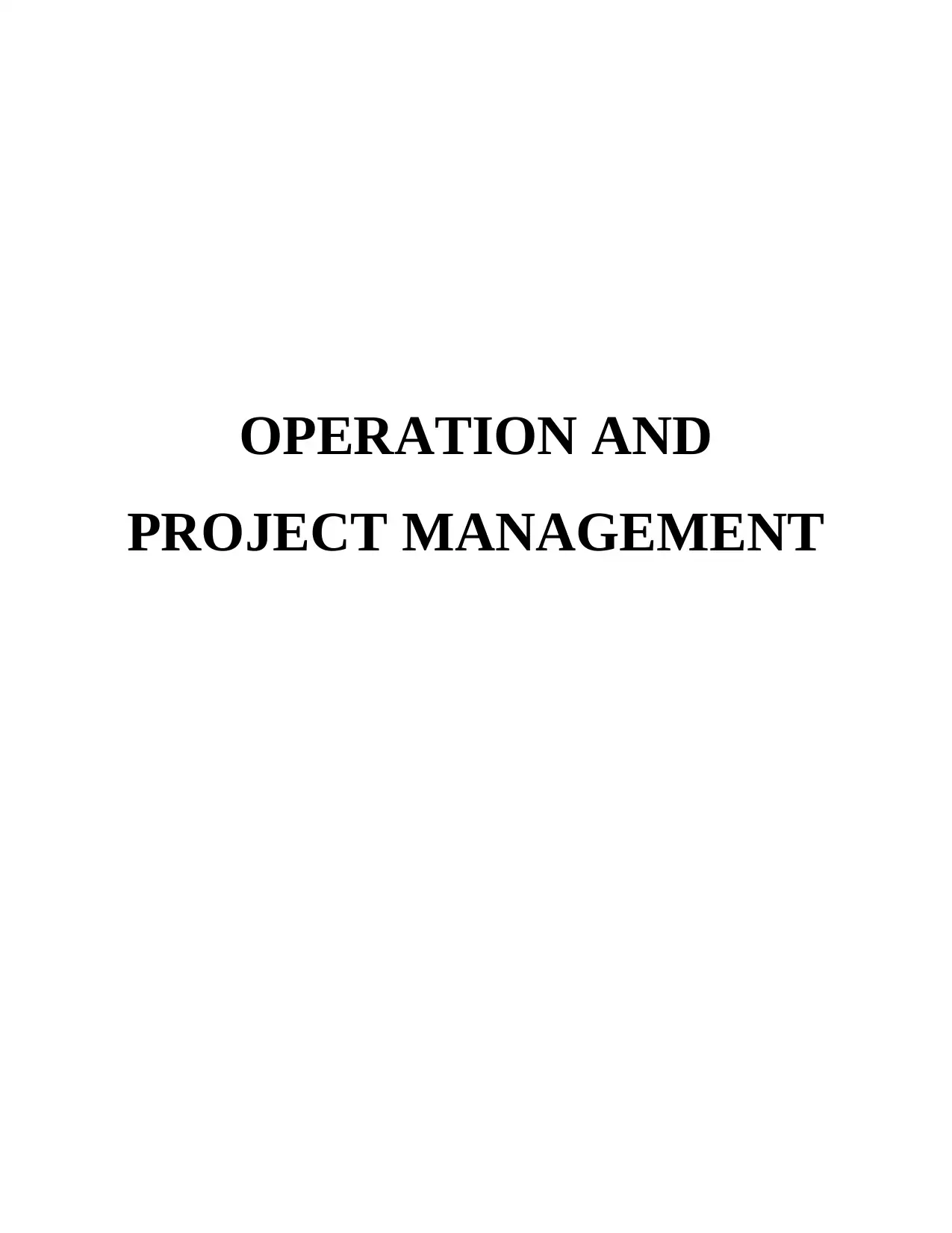
OPERATION AND
PROJECT MANAGEMENT
PROJECT MANAGEMENT
Secure Best Marks with AI Grader
Need help grading? Try our AI Grader for instant feedback on your assignments.
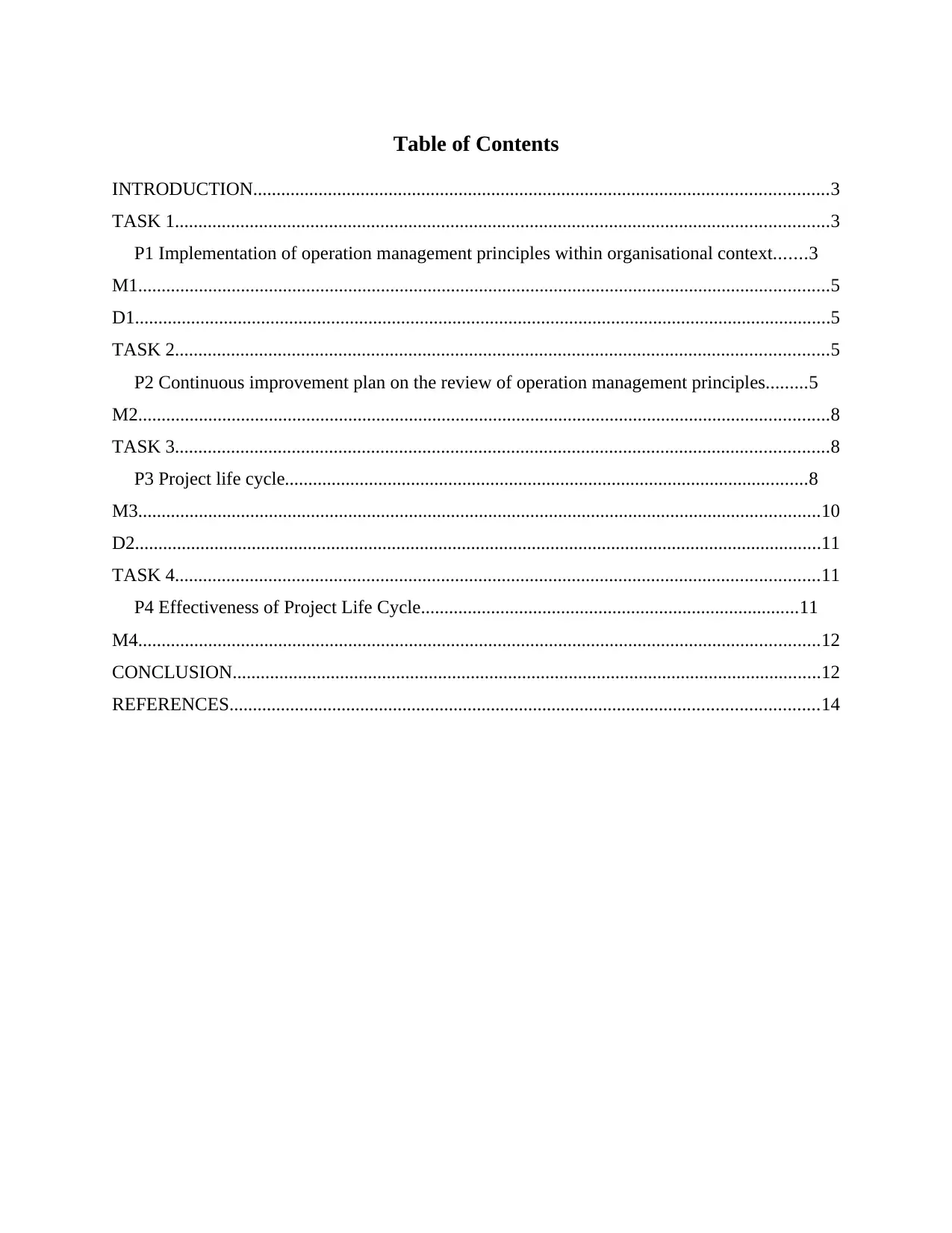
Table of Contents
INTRODUCTION...........................................................................................................................3
TASK 1............................................................................................................................................3
P1 Implementation of operation management principles within organisational context.......3
M1....................................................................................................................................................5
D1.....................................................................................................................................................5
TASK 2............................................................................................................................................5
P2 Continuous improvement plan on the review of operation management principles.........5
M2....................................................................................................................................................8
TASK 3............................................................................................................................................8
P3 Project life cycle................................................................................................................8
M3..................................................................................................................................................10
D2...................................................................................................................................................11
TASK 4..........................................................................................................................................11
P4 Effectiveness of Project Life Cycle.................................................................................11
M4..................................................................................................................................................12
CONCLUSION..............................................................................................................................12
REFERENCES..............................................................................................................................14
INTRODUCTION...........................................................................................................................3
TASK 1............................................................................................................................................3
P1 Implementation of operation management principles within organisational context.......3
M1....................................................................................................................................................5
D1.....................................................................................................................................................5
TASK 2............................................................................................................................................5
P2 Continuous improvement plan on the review of operation management principles.........5
M2....................................................................................................................................................8
TASK 3............................................................................................................................................8
P3 Project life cycle................................................................................................................8
M3..................................................................................................................................................10
D2...................................................................................................................................................11
TASK 4..........................................................................................................................................11
P4 Effectiveness of Project Life Cycle.................................................................................11
M4..................................................................................................................................................12
CONCLUSION..............................................................................................................................12
REFERENCES..............................................................................................................................14
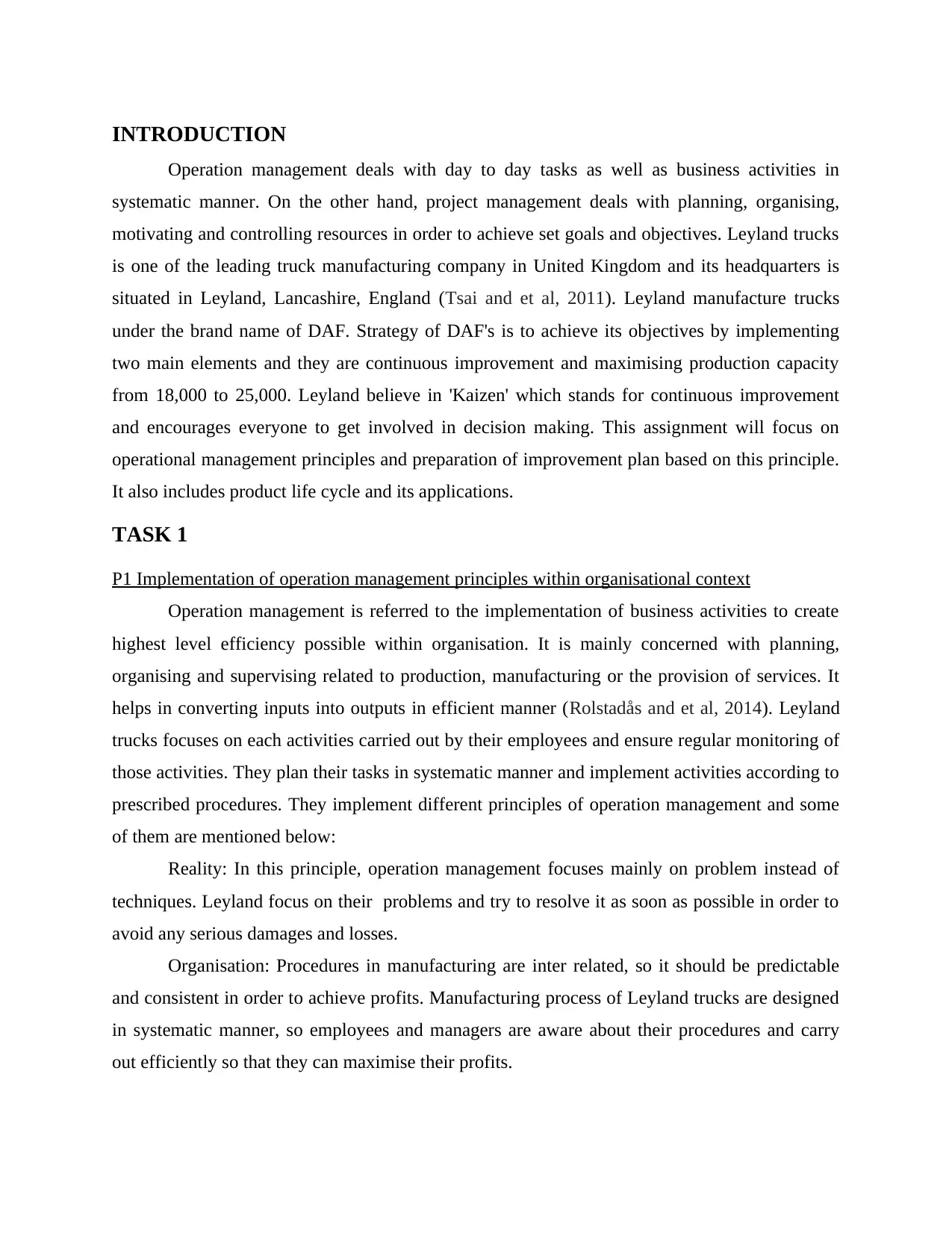
INTRODUCTION
Operation management deals with day to day tasks as well as business activities in
systematic manner. On the other hand, project management deals with planning, organising,
motivating and controlling resources in order to achieve set goals and objectives. Leyland trucks
is one of the leading truck manufacturing company in United Kingdom and its headquarters is
situated in Leyland, Lancashire, England (Tsai and et al, 2011). Leyland manufacture trucks
under the brand name of DAF. Strategy of DAF's is to achieve its objectives by implementing
two main elements and they are continuous improvement and maximising production capacity
from 18,000 to 25,000. Leyland believe in 'Kaizen' which stands for continuous improvement
and encourages everyone to get involved in decision making. This assignment will focus on
operational management principles and preparation of improvement plan based on this principle.
It also includes product life cycle and its applications.
TASK 1
P1 Implementation of operation management principles within organisational context
Operation management is referred to the implementation of business activities to create
highest level efficiency possible within organisation. It is mainly concerned with planning,
organising and supervising related to production, manufacturing or the provision of services. It
helps in converting inputs into outputs in efficient manner (Rolstadås and et al, 2014). Leyland
trucks focuses on each activities carried out by their employees and ensure regular monitoring of
those activities. They plan their tasks in systematic manner and implement activities according to
prescribed procedures. They implement different principles of operation management and some
of them are mentioned below:
Reality: In this principle, operation management focuses mainly on problem instead of
techniques. Leyland focus on their problems and try to resolve it as soon as possible in order to
avoid any serious damages and losses.
Organisation: Procedures in manufacturing are inter related, so it should be predictable
and consistent in order to achieve profits. Manufacturing process of Leyland trucks are designed
in systematic manner, so employees and managers are aware about their procedures and carry
out efficiently so that they can maximise their profits.
Operation management deals with day to day tasks as well as business activities in
systematic manner. On the other hand, project management deals with planning, organising,
motivating and controlling resources in order to achieve set goals and objectives. Leyland trucks
is one of the leading truck manufacturing company in United Kingdom and its headquarters is
situated in Leyland, Lancashire, England (Tsai and et al, 2011). Leyland manufacture trucks
under the brand name of DAF. Strategy of DAF's is to achieve its objectives by implementing
two main elements and they are continuous improvement and maximising production capacity
from 18,000 to 25,000. Leyland believe in 'Kaizen' which stands for continuous improvement
and encourages everyone to get involved in decision making. This assignment will focus on
operational management principles and preparation of improvement plan based on this principle.
It also includes product life cycle and its applications.
TASK 1
P1 Implementation of operation management principles within organisational context
Operation management is referred to the implementation of business activities to create
highest level efficiency possible within organisation. It is mainly concerned with planning,
organising and supervising related to production, manufacturing or the provision of services. It
helps in converting inputs into outputs in efficient manner (Rolstadås and et al, 2014). Leyland
trucks focuses on each activities carried out by their employees and ensure regular monitoring of
those activities. They plan their tasks in systematic manner and implement activities according to
prescribed procedures. They implement different principles of operation management and some
of them are mentioned below:
Reality: In this principle, operation management focuses mainly on problem instead of
techniques. Leyland focus on their problems and try to resolve it as soon as possible in order to
avoid any serious damages and losses.
Organisation: Procedures in manufacturing are inter related, so it should be predictable
and consistent in order to achieve profits. Manufacturing process of Leyland trucks are designed
in systematic manner, so employees and managers are aware about their procedures and carry
out efficiently so that they can maximise their profits.
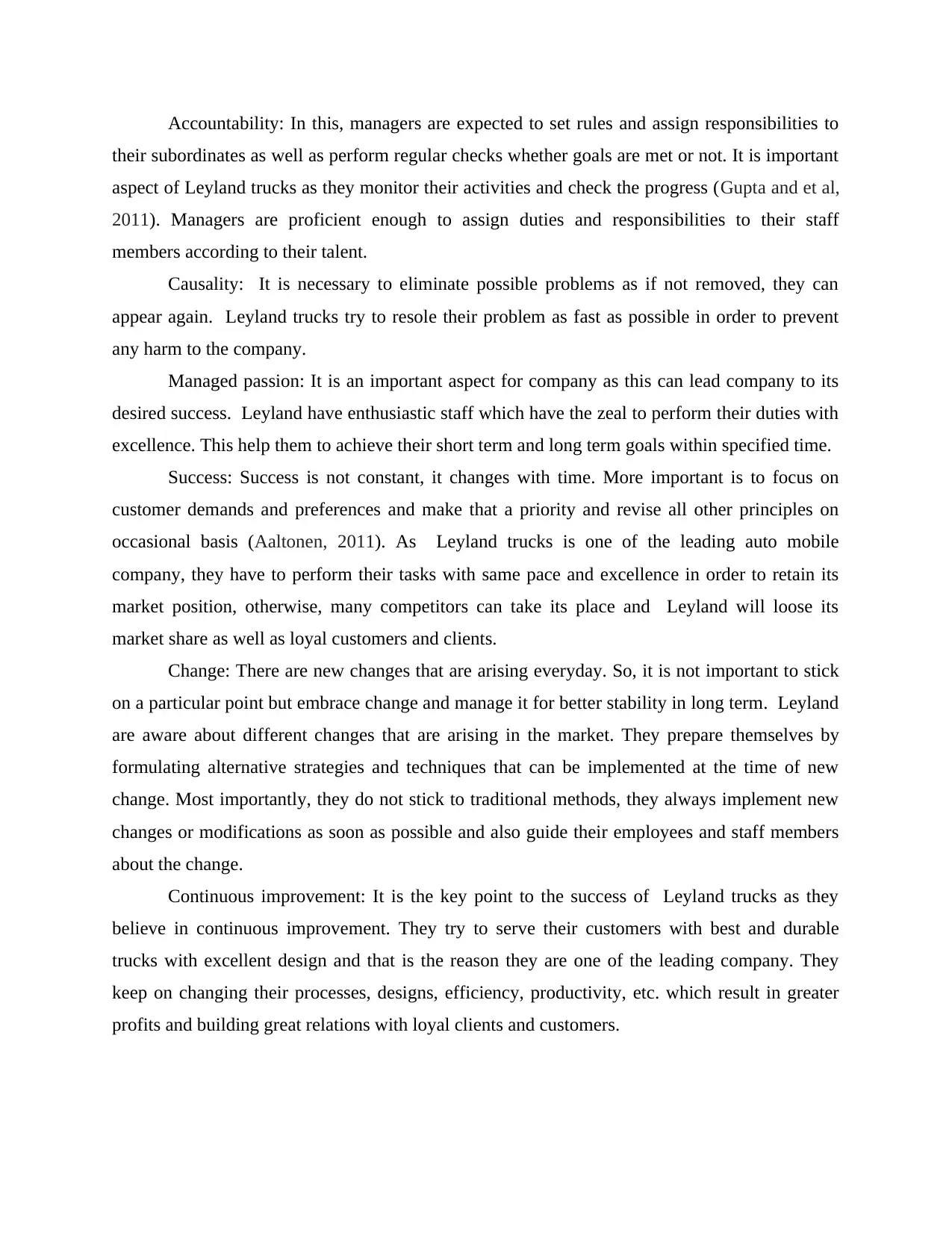
Accountability: In this, managers are expected to set rules and assign responsibilities to
their subordinates as well as perform regular checks whether goals are met or not. It is important
aspect of Leyland trucks as they monitor their activities and check the progress (Gupta and et al,
2011). Managers are proficient enough to assign duties and responsibilities to their staff
members according to their talent.
Causality: It is necessary to eliminate possible problems as if not removed, they can
appear again. Leyland trucks try to resole their problem as fast as possible in order to prevent
any harm to the company.
Managed passion: It is an important aspect for company as this can lead company to its
desired success. Leyland have enthusiastic staff which have the zeal to perform their duties with
excellence. This help them to achieve their short term and long term goals within specified time.
Success: Success is not constant, it changes with time. More important is to focus on
customer demands and preferences and make that a priority and revise all other principles on
occasional basis (Aaltonen, 2011). As Leyland trucks is one of the leading auto mobile
company, they have to perform their tasks with same pace and excellence in order to retain its
market position, otherwise, many competitors can take its place and Leyland will loose its
market share as well as loyal customers and clients.
Change: There are new changes that are arising everyday. So, it is not important to stick
on a particular point but embrace change and manage it for better stability in long term. Leyland
are aware about different changes that are arising in the market. They prepare themselves by
formulating alternative strategies and techniques that can be implemented at the time of new
change. Most importantly, they do not stick to traditional methods, they always implement new
changes or modifications as soon as possible and also guide their employees and staff members
about the change.
Continuous improvement: It is the key point to the success of Leyland trucks as they
believe in continuous improvement. They try to serve their customers with best and durable
trucks with excellent design and that is the reason they are one of the leading company. They
keep on changing their processes, designs, efficiency, productivity, etc. which result in greater
profits and building great relations with loyal clients and customers.
their subordinates as well as perform regular checks whether goals are met or not. It is important
aspect of Leyland trucks as they monitor their activities and check the progress (Gupta and et al,
2011). Managers are proficient enough to assign duties and responsibilities to their staff
members according to their talent.
Causality: It is necessary to eliminate possible problems as if not removed, they can
appear again. Leyland trucks try to resole their problem as fast as possible in order to prevent
any harm to the company.
Managed passion: It is an important aspect for company as this can lead company to its
desired success. Leyland have enthusiastic staff which have the zeal to perform their duties with
excellence. This help them to achieve their short term and long term goals within specified time.
Success: Success is not constant, it changes with time. More important is to focus on
customer demands and preferences and make that a priority and revise all other principles on
occasional basis (Aaltonen, 2011). As Leyland trucks is one of the leading auto mobile
company, they have to perform their tasks with same pace and excellence in order to retain its
market position, otherwise, many competitors can take its place and Leyland will loose its
market share as well as loyal customers and clients.
Change: There are new changes that are arising everyday. So, it is not important to stick
on a particular point but embrace change and manage it for better stability in long term. Leyland
are aware about different changes that are arising in the market. They prepare themselves by
formulating alternative strategies and techniques that can be implemented at the time of new
change. Most importantly, they do not stick to traditional methods, they always implement new
changes or modifications as soon as possible and also guide their employees and staff members
about the change.
Continuous improvement: It is the key point to the success of Leyland trucks as they
believe in continuous improvement. They try to serve their customers with best and durable
trucks with excellent design and that is the reason they are one of the leading company. They
keep on changing their processes, designs, efficiency, productivity, etc. which result in greater
profits and building great relations with loyal clients and customers.
Secure Best Marks with AI Grader
Need help grading? Try our AI Grader for instant feedback on your assignments.
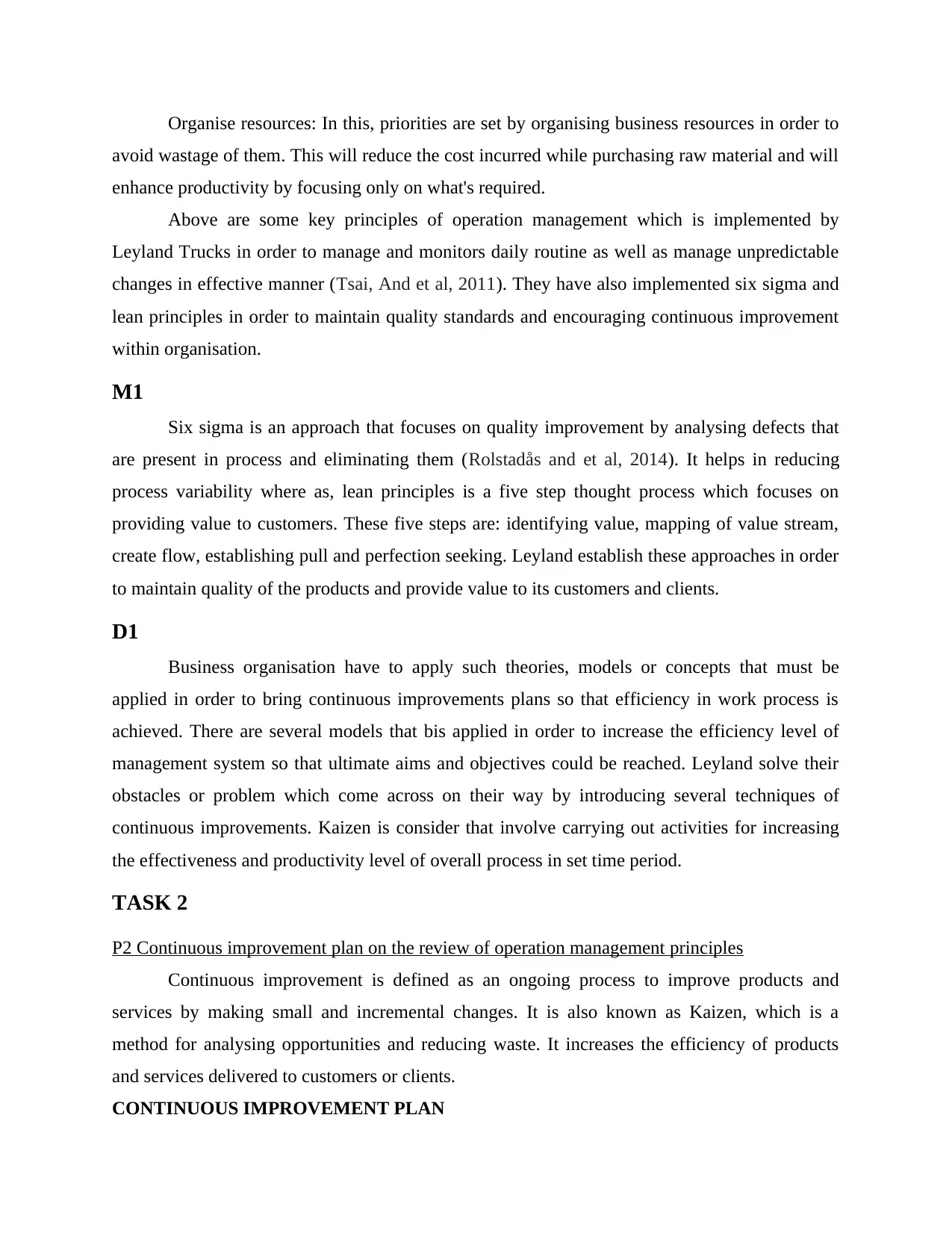
Organise resources: In this, priorities are set by organising business resources in order to
avoid wastage of them. This will reduce the cost incurred while purchasing raw material and will
enhance productivity by focusing only on what's required.
Above are some key principles of operation management which is implemented by
Leyland Trucks in order to manage and monitors daily routine as well as manage unpredictable
changes in effective manner (Tsai, And et al, 2011). They have also implemented six sigma and
lean principles in order to maintain quality standards and encouraging continuous improvement
within organisation.
M1
Six sigma is an approach that focuses on quality improvement by analysing defects that
are present in process and eliminating them (Rolstadås and et al, 2014). It helps in reducing
process variability where as, lean principles is a five step thought process which focuses on
providing value to customers. These five steps are: identifying value, mapping of value stream,
create flow, establishing pull and perfection seeking. Leyland establish these approaches in order
to maintain quality of the products and provide value to its customers and clients.
D1
Business organisation have to apply such theories, models or concepts that must be
applied in order to bring continuous improvements plans so that efficiency in work process is
achieved. There are several models that bis applied in order to increase the efficiency level of
management system so that ultimate aims and objectives could be reached. Leyland solve their
obstacles or problem which come across on their way by introducing several techniques of
continuous improvements. Kaizen is consider that involve carrying out activities for increasing
the effectiveness and productivity level of overall process in set time period.
TASK 2
P2 Continuous improvement plan on the review of operation management principles
Continuous improvement is defined as an ongoing process to improve products and
services by making small and incremental changes. It is also known as Kaizen, which is a
method for analysing opportunities and reducing waste. It increases the efficiency of products
and services delivered to customers or clients.
CONTINUOUS IMPROVEMENT PLAN
avoid wastage of them. This will reduce the cost incurred while purchasing raw material and will
enhance productivity by focusing only on what's required.
Above are some key principles of operation management which is implemented by
Leyland Trucks in order to manage and monitors daily routine as well as manage unpredictable
changes in effective manner (Tsai, And et al, 2011). They have also implemented six sigma and
lean principles in order to maintain quality standards and encouraging continuous improvement
within organisation.
M1
Six sigma is an approach that focuses on quality improvement by analysing defects that
are present in process and eliminating them (Rolstadås and et al, 2014). It helps in reducing
process variability where as, lean principles is a five step thought process which focuses on
providing value to customers. These five steps are: identifying value, mapping of value stream,
create flow, establishing pull and perfection seeking. Leyland establish these approaches in order
to maintain quality of the products and provide value to its customers and clients.
D1
Business organisation have to apply such theories, models or concepts that must be
applied in order to bring continuous improvements plans so that efficiency in work process is
achieved. There are several models that bis applied in order to increase the efficiency level of
management system so that ultimate aims and objectives could be reached. Leyland solve their
obstacles or problem which come across on their way by introducing several techniques of
continuous improvements. Kaizen is consider that involve carrying out activities for increasing
the effectiveness and productivity level of overall process in set time period.
TASK 2
P2 Continuous improvement plan on the review of operation management principles
Continuous improvement is defined as an ongoing process to improve products and
services by making small and incremental changes. It is also known as Kaizen, which is a
method for analysing opportunities and reducing waste. It increases the efficiency of products
and services delivered to customers or clients.
CONTINUOUS IMPROVEMENT PLAN
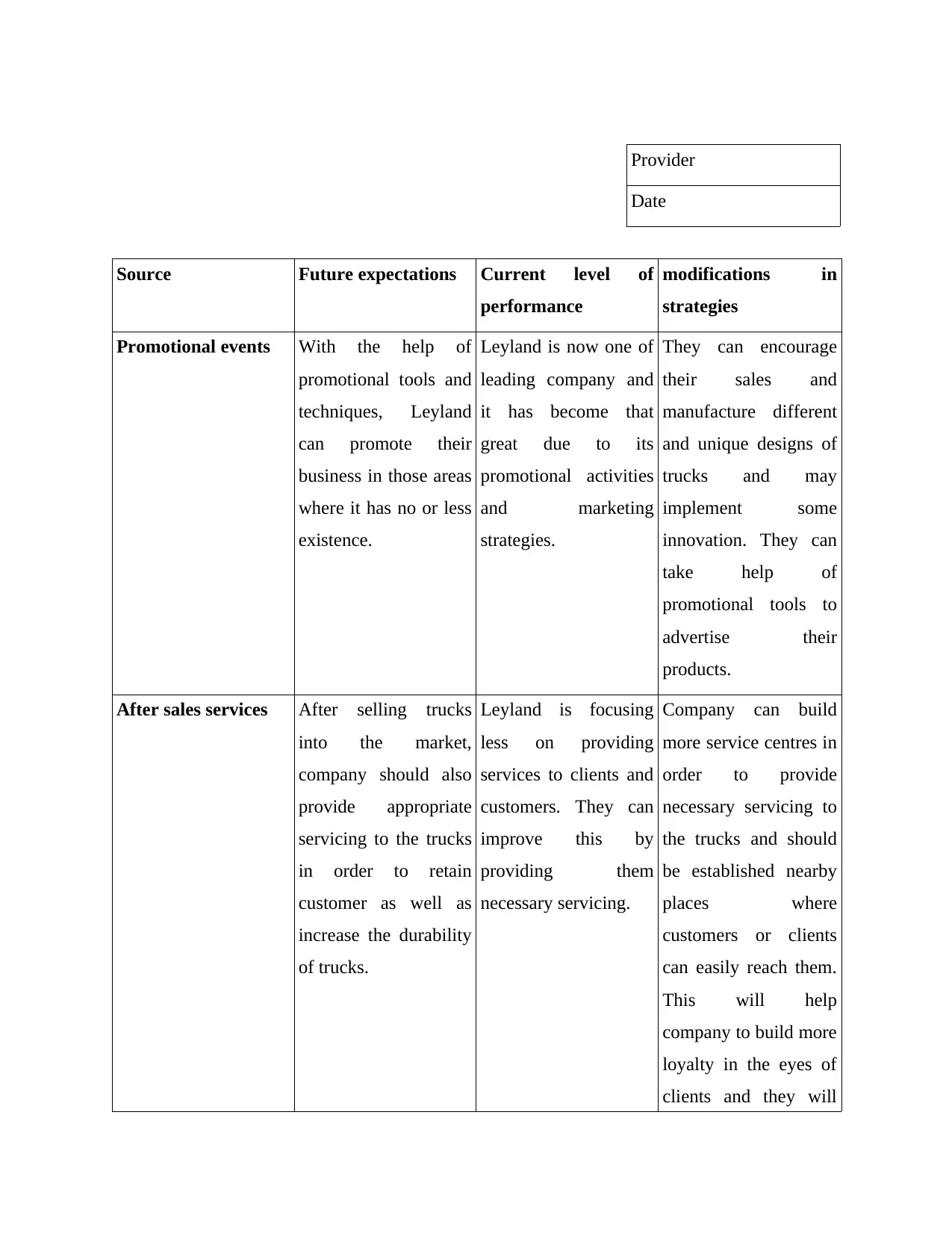
Provider
Date
Source Future expectations Current level of
performance
modifications in
strategies
Promotional events With the help of
promotional tools and
techniques, Leyland
can promote their
business in those areas
where it has no or less
existence.
Leyland is now one of
leading company and
it has become that
great due to its
promotional activities
and marketing
strategies.
They can encourage
their sales and
manufacture different
and unique designs of
trucks and may
implement some
innovation. They can
take help of
promotional tools to
advertise their
products.
After sales services After selling trucks
into the market,
company should also
provide appropriate
servicing to the trucks
in order to retain
customer as well as
increase the durability
of trucks.
Leyland is focusing
less on providing
services to clients and
customers. They can
improve this by
providing them
necessary servicing.
Company can build
more service centres in
order to provide
necessary servicing to
the trucks and should
be established nearby
places where
customers or clients
can easily reach them.
This will help
company to build more
loyalty in the eyes of
clients and they will
Date
Source Future expectations Current level of
performance
modifications in
strategies
Promotional events With the help of
promotional tools and
techniques, Leyland
can promote their
business in those areas
where it has no or less
existence.
Leyland is now one of
leading company and
it has become that
great due to its
promotional activities
and marketing
strategies.
They can encourage
their sales and
manufacture different
and unique designs of
trucks and may
implement some
innovation. They can
take help of
promotional tools to
advertise their
products.
After sales services After selling trucks
into the market,
company should also
provide appropriate
servicing to the trucks
in order to retain
customer as well as
increase the durability
of trucks.
Leyland is focusing
less on providing
services to clients and
customers. They can
improve this by
providing them
necessary servicing.
Company can build
more service centres in
order to provide
necessary servicing to
the trucks and should
be established nearby
places where
customers or clients
can easily reach them.
This will help
company to build more
loyalty in the eyes of
clients and they will
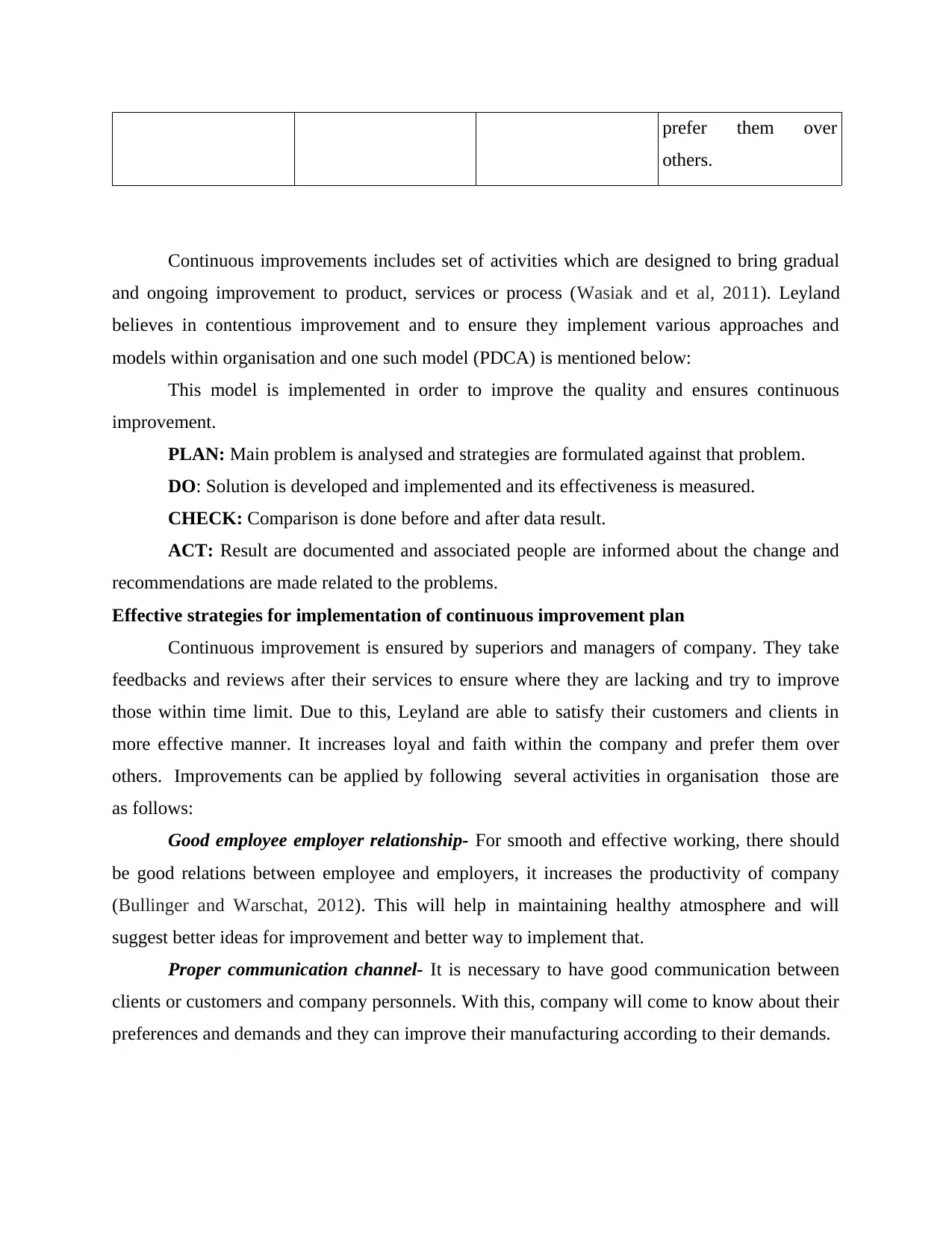
prefer them over
others.
Continuous improvements includes set of activities which are designed to bring gradual
and ongoing improvement to product, services or process (Wasiak and et al, 2011). Leyland
believes in contentious improvement and to ensure they implement various approaches and
models within organisation and one such model (PDCA) is mentioned below:
This model is implemented in order to improve the quality and ensures continuous
improvement.
PLAN: Main problem is analysed and strategies are formulated against that problem.
DO: Solution is developed and implemented and its effectiveness is measured.
CHECK: Comparison is done before and after data result.
ACT: Result are documented and associated people are informed about the change and
recommendations are made related to the problems.
Effective strategies for implementation of continuous improvement plan
Continuous improvement is ensured by superiors and managers of company. They take
feedbacks and reviews after their services to ensure where they are lacking and try to improve
those within time limit. Due to this, Leyland are able to satisfy their customers and clients in
more effective manner. It increases loyal and faith within the company and prefer them over
others. Improvements can be applied by following several activities in organisation those are
as follows:
Good employee employer relationship- For smooth and effective working, there should
be good relations between employee and employers, it increases the productivity of company
(Bullinger and Warschat, 2012). This will help in maintaining healthy atmosphere and will
suggest better ideas for improvement and better way to implement that.
Proper communication channel- It is necessary to have good communication between
clients or customers and company personnels. With this, company will come to know about their
preferences and demands and they can improve their manufacturing according to their demands.
others.
Continuous improvements includes set of activities which are designed to bring gradual
and ongoing improvement to product, services or process (Wasiak and et al, 2011). Leyland
believes in contentious improvement and to ensure they implement various approaches and
models within organisation and one such model (PDCA) is mentioned below:
This model is implemented in order to improve the quality and ensures continuous
improvement.
PLAN: Main problem is analysed and strategies are formulated against that problem.
DO: Solution is developed and implemented and its effectiveness is measured.
CHECK: Comparison is done before and after data result.
ACT: Result are documented and associated people are informed about the change and
recommendations are made related to the problems.
Effective strategies for implementation of continuous improvement plan
Continuous improvement is ensured by superiors and managers of company. They take
feedbacks and reviews after their services to ensure where they are lacking and try to improve
those within time limit. Due to this, Leyland are able to satisfy their customers and clients in
more effective manner. It increases loyal and faith within the company and prefer them over
others. Improvements can be applied by following several activities in organisation those are
as follows:
Good employee employer relationship- For smooth and effective working, there should
be good relations between employee and employers, it increases the productivity of company
(Bullinger and Warschat, 2012). This will help in maintaining healthy atmosphere and will
suggest better ideas for improvement and better way to implement that.
Proper communication channel- It is necessary to have good communication between
clients or customers and company personnels. With this, company will come to know about their
preferences and demands and they can improve their manufacturing according to their demands.
Paraphrase This Document
Need a fresh take? Get an instant paraphrase of this document with our AI Paraphraser
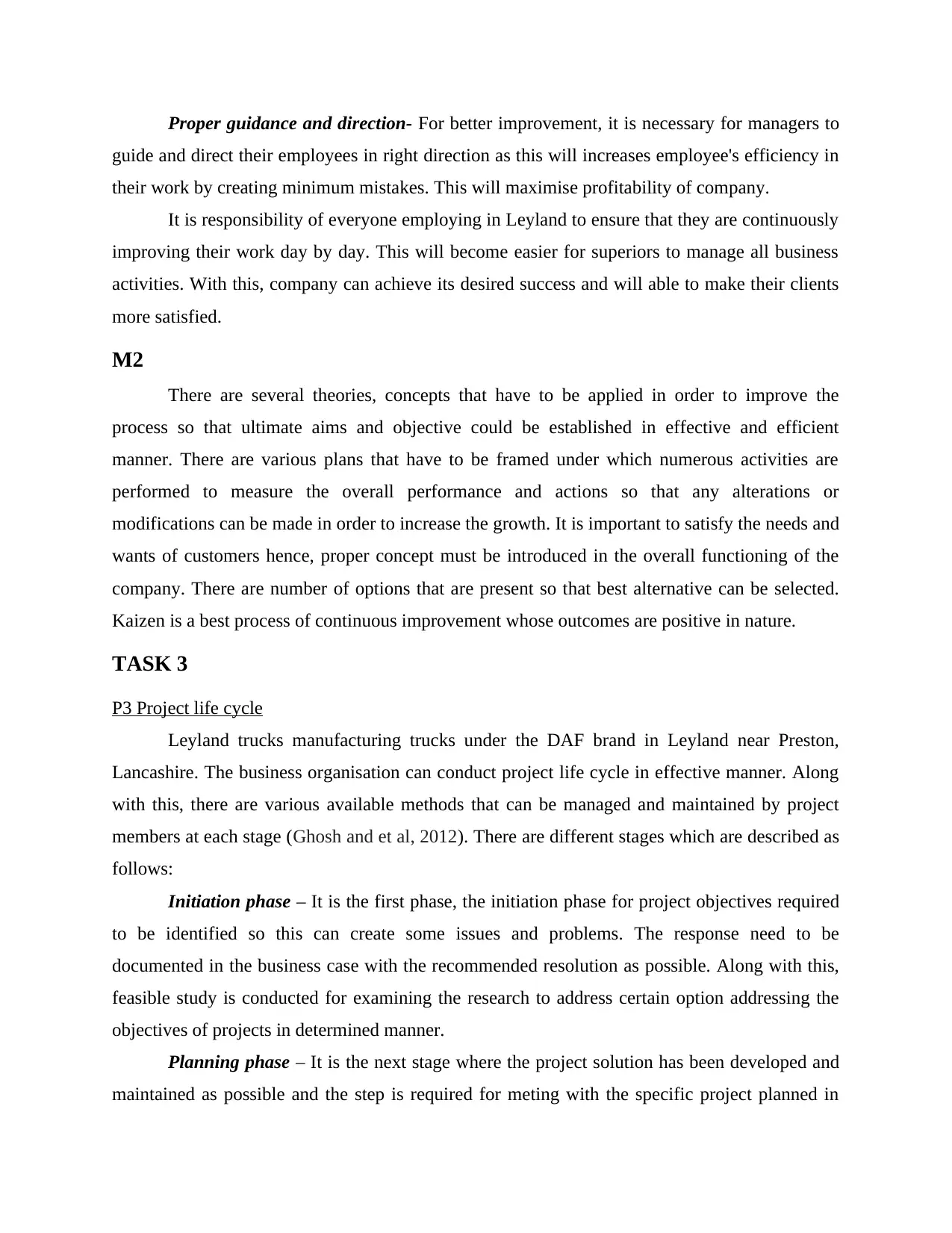
Proper guidance and direction- For better improvement, it is necessary for managers to
guide and direct their employees in right direction as this will increases employee's efficiency in
their work by creating minimum mistakes. This will maximise profitability of company.
It is responsibility of everyone employing in Leyland to ensure that they are continuously
improving their work day by day. This will become easier for superiors to manage all business
activities. With this, company can achieve its desired success and will able to make their clients
more satisfied.
M2
There are several theories, concepts that have to be applied in order to improve the
process so that ultimate aims and objective could be established in effective and efficient
manner. There are various plans that have to be framed under which numerous activities are
performed to measure the overall performance and actions so that any alterations or
modifications can be made in order to increase the growth. It is important to satisfy the needs and
wants of customers hence, proper concept must be introduced in the overall functioning of the
company. There are number of options that are present so that best alternative can be selected.
Kaizen is a best process of continuous improvement whose outcomes are positive in nature.
TASK 3
P3 Project life cycle
Leyland trucks manufacturing trucks under the DAF brand in Leyland near Preston,
Lancashire. The business organisation can conduct project life cycle in effective manner. Along
with this, there are various available methods that can be managed and maintained by project
members at each stage (Ghosh and et al, 2012). There are different stages which are described as
follows:
Initiation phase – It is the first phase, the initiation phase for project objectives required
to be identified so this can create some issues and problems. The response need to be
documented in the business case with the recommended resolution as possible. Along with this,
feasible study is conducted for examining the research to address certain option addressing the
objectives of projects in determined manner.
Planning phase – It is the next stage where the project solution has been developed and
maintained as possible and the step is required for meting with the specific project planned in
guide and direct their employees in right direction as this will increases employee's efficiency in
their work by creating minimum mistakes. This will maximise profitability of company.
It is responsibility of everyone employing in Leyland to ensure that they are continuously
improving their work day by day. This will become easier for superiors to manage all business
activities. With this, company can achieve its desired success and will able to make their clients
more satisfied.
M2
There are several theories, concepts that have to be applied in order to improve the
process so that ultimate aims and objective could be established in effective and efficient
manner. There are various plans that have to be framed under which numerous activities are
performed to measure the overall performance and actions so that any alterations or
modifications can be made in order to increase the growth. It is important to satisfy the needs and
wants of customers hence, proper concept must be introduced in the overall functioning of the
company. There are number of options that are present so that best alternative can be selected.
Kaizen is a best process of continuous improvement whose outcomes are positive in nature.
TASK 3
P3 Project life cycle
Leyland trucks manufacturing trucks under the DAF brand in Leyland near Preston,
Lancashire. The business organisation can conduct project life cycle in effective manner. Along
with this, there are various available methods that can be managed and maintained by project
members at each stage (Ghosh and et al, 2012). There are different stages which are described as
follows:
Initiation phase – It is the first phase, the initiation phase for project objectives required
to be identified so this can create some issues and problems. The response need to be
documented in the business case with the recommended resolution as possible. Along with this,
feasible study is conducted for examining the research to address certain option addressing the
objectives of projects in determined manner.
Planning phase – It is the next stage where the project solution has been developed and
maintained as possible and the step is required for meting with the specific project planned in
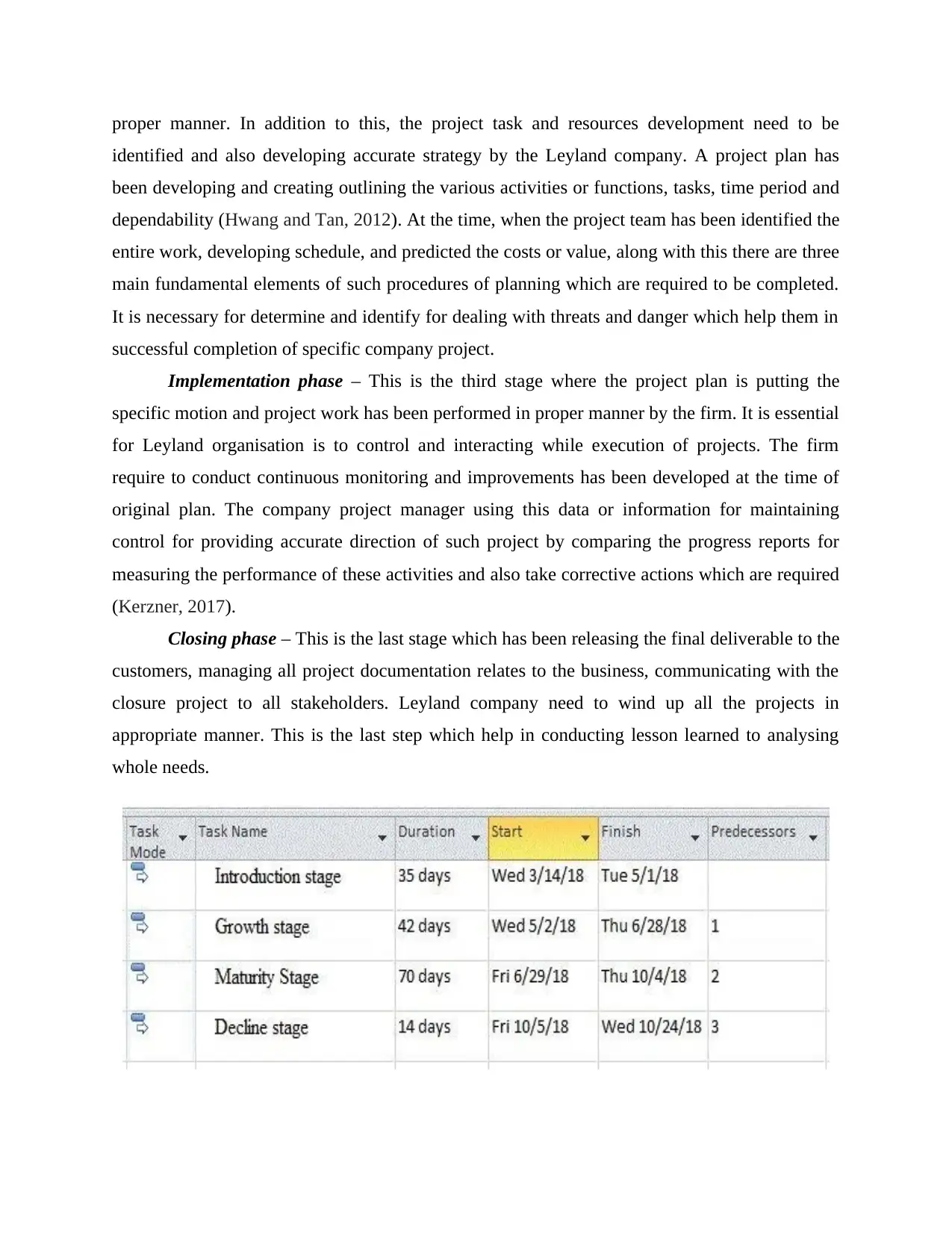
proper manner. In addition to this, the project task and resources development need to be
identified and also developing accurate strategy by the Leyland company. A project plan has
been developing and creating outlining the various activities or functions, tasks, time period and
dependability (Hwang and Tan, 2012). At the time, when the project team has been identified the
entire work, developing schedule, and predicted the costs or value, along with this there are three
main fundamental elements of such procedures of planning which are required to be completed.
It is necessary for determine and identify for dealing with threats and danger which help them in
successful completion of specific company project.
Implementation phase – This is the third stage where the project plan is putting the
specific motion and project work has been performed in proper manner by the firm. It is essential
for Leyland organisation is to control and interacting while execution of projects. The firm
require to conduct continuous monitoring and improvements has been developed at the time of
original plan. The company project manager using this data or information for maintaining
control for providing accurate direction of such project by comparing the progress reports for
measuring the performance of these activities and also take corrective actions which are required
(Kerzner, 2017).
Closing phase – This is the last stage which has been releasing the final deliverable to the
customers, managing all project documentation relates to the business, communicating with the
closure project to all stakeholders. Leyland company need to wind up all the projects in
appropriate manner. This is the last step which help in conducting lesson learned to analysing
whole needs.
identified and also developing accurate strategy by the Leyland company. A project plan has
been developing and creating outlining the various activities or functions, tasks, time period and
dependability (Hwang and Tan, 2012). At the time, when the project team has been identified the
entire work, developing schedule, and predicted the costs or value, along with this there are three
main fundamental elements of such procedures of planning which are required to be completed.
It is necessary for determine and identify for dealing with threats and danger which help them in
successful completion of specific company project.
Implementation phase – This is the third stage where the project plan is putting the
specific motion and project work has been performed in proper manner by the firm. It is essential
for Leyland organisation is to control and interacting while execution of projects. The firm
require to conduct continuous monitoring and improvements has been developed at the time of
original plan. The company project manager using this data or information for maintaining
control for providing accurate direction of such project by comparing the progress reports for
measuring the performance of these activities and also take corrective actions which are required
(Kerzner, 2017).
Closing phase – This is the last stage which has been releasing the final deliverable to the
customers, managing all project documentation relates to the business, communicating with the
closure project to all stakeholders. Leyland company need to wind up all the projects in
appropriate manner. This is the last step which help in conducting lesson learned to analysing
whole needs.
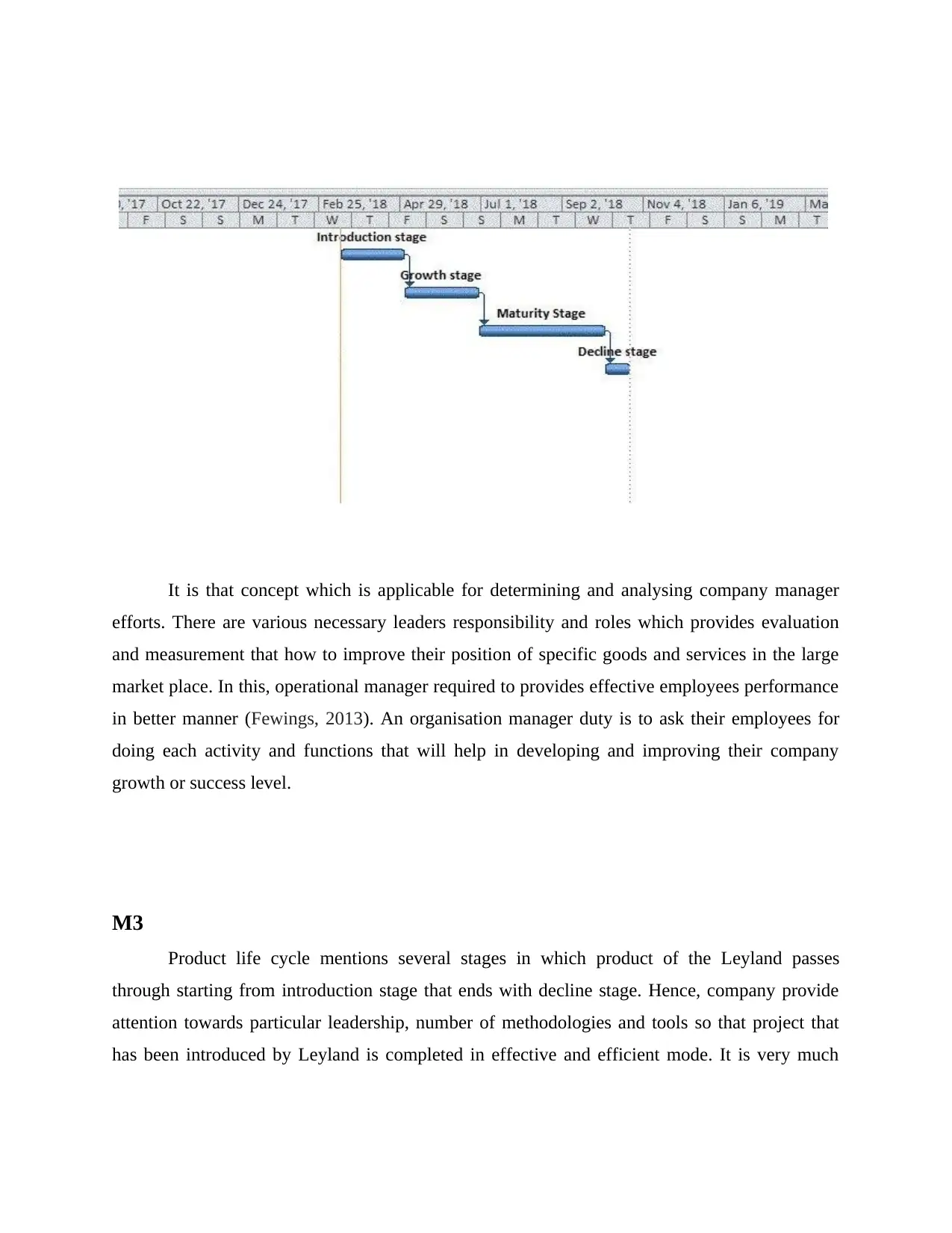
It is that concept which is applicable for determining and analysing company manager
efforts. There are various necessary leaders responsibility and roles which provides evaluation
and measurement that how to improve their position of specific goods and services in the large
market place. In this, operational manager required to provides effective employees performance
in better manner (Fewings, 2013). An organisation manager duty is to ask their employees for
doing each activity and functions that will help in developing and improving their company
growth or success level.
M3
Product life cycle mentions several stages in which product of the Leyland passes
through starting from introduction stage that ends with decline stage. Hence, company provide
attention towards particular leadership, number of methodologies and tools so that project that
has been introduced by Leyland is completed in effective and efficient mode. It is very much
efforts. There are various necessary leaders responsibility and roles which provides evaluation
and measurement that how to improve their position of specific goods and services in the large
market place. In this, operational manager required to provides effective employees performance
in better manner (Fewings, 2013). An organisation manager duty is to ask their employees for
doing each activity and functions that will help in developing and improving their company
growth or success level.
M3
Product life cycle mentions several stages in which product of the Leyland passes
through starting from introduction stage that ends with decline stage. Hence, company provide
attention towards particular leadership, number of methodologies and tools so that project that
has been introduced by Leyland is completed in effective and efficient mode. It is very much
Secure Best Marks with AI Grader
Need help grading? Try our AI Grader for instant feedback on your assignments.
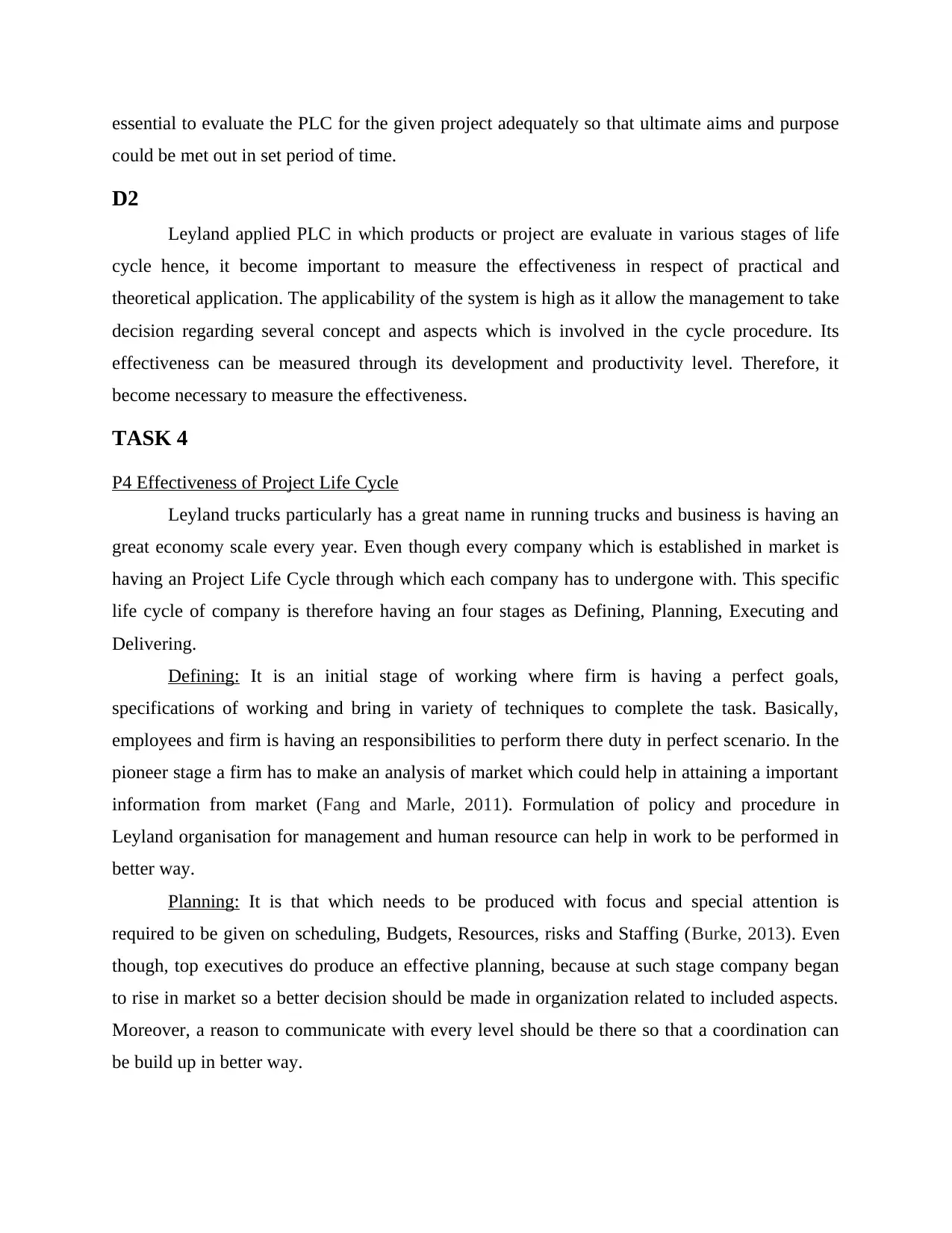
essential to evaluate the PLC for the given project adequately so that ultimate aims and purpose
could be met out in set period of time.
D2
Leyland applied PLC in which products or project are evaluate in various stages of life
cycle hence, it become important to measure the effectiveness in respect of practical and
theoretical application. The applicability of the system is high as it allow the management to take
decision regarding several concept and aspects which is involved in the cycle procedure. Its
effectiveness can be measured through its development and productivity level. Therefore, it
become necessary to measure the effectiveness.
TASK 4
P4 Effectiveness of Project Life Cycle
Leyland trucks particularly has a great name in running trucks and business is having an
great economy scale every year. Even though every company which is established in market is
having an Project Life Cycle through which each company has to undergone with. This specific
life cycle of company is therefore having an four stages as Defining, Planning, Executing and
Delivering.
Defining: It is an initial stage of working where firm is having a perfect goals,
specifications of working and bring in variety of techniques to complete the task. Basically,
employees and firm is having an responsibilities to perform there duty in perfect scenario. In the
pioneer stage a firm has to make an analysis of market which could help in attaining a important
information from market (Fang and Marle, 2011). Formulation of policy and procedure in
Leyland organisation for management and human resource can help in work to be performed in
better way.
Planning: It is that which needs to be produced with focus and special attention is
required to be given on scheduling, Budgets, Resources, risks and Staffing (Burke, 2013). Even
though, top executives do produce an effective planning, because at such stage company began
to rise in market so a better decision should be made in organization related to included aspects.
Moreover, a reason to communicate with every level should be there so that a coordination can
be build up in better way.
could be met out in set period of time.
D2
Leyland applied PLC in which products or project are evaluate in various stages of life
cycle hence, it become important to measure the effectiveness in respect of practical and
theoretical application. The applicability of the system is high as it allow the management to take
decision regarding several concept and aspects which is involved in the cycle procedure. Its
effectiveness can be measured through its development and productivity level. Therefore, it
become necessary to measure the effectiveness.
TASK 4
P4 Effectiveness of Project Life Cycle
Leyland trucks particularly has a great name in running trucks and business is having an
great economy scale every year. Even though every company which is established in market is
having an Project Life Cycle through which each company has to undergone with. This specific
life cycle of company is therefore having an four stages as Defining, Planning, Executing and
Delivering.
Defining: It is an initial stage of working where firm is having a perfect goals,
specifications of working and bring in variety of techniques to complete the task. Basically,
employees and firm is having an responsibilities to perform there duty in perfect scenario. In the
pioneer stage a firm has to make an analysis of market which could help in attaining a important
information from market (Fang and Marle, 2011). Formulation of policy and procedure in
Leyland organisation for management and human resource can help in work to be performed in
better way.
Planning: It is that which needs to be produced with focus and special attention is
required to be given on scheduling, Budgets, Resources, risks and Staffing (Burke, 2013). Even
though, top executives do produce an effective planning, because at such stage company began
to rise in market so a better decision should be made in organization related to included aspects.
Moreover, a reason to communicate with every level should be there so that a coordination can
be build up in better way.
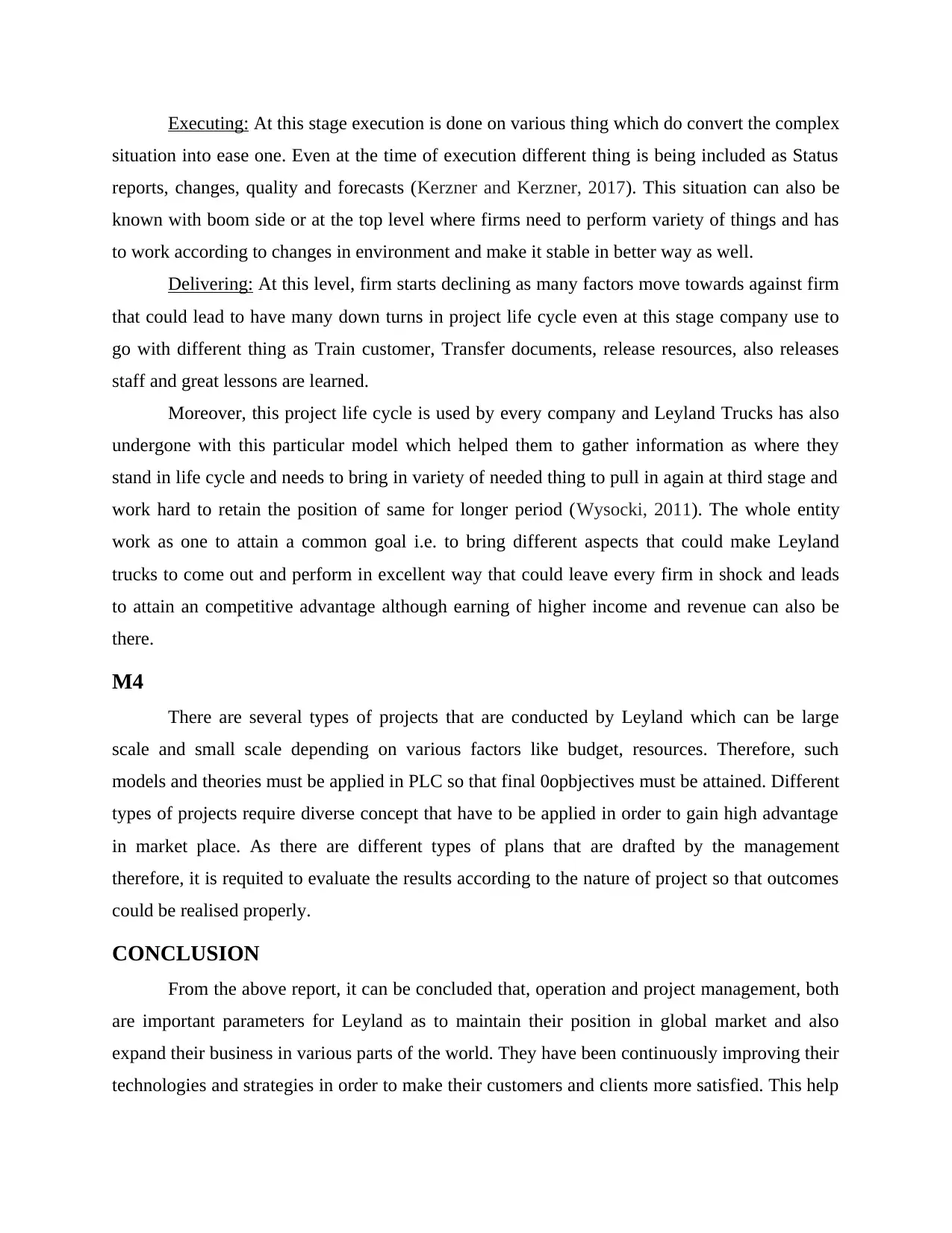
Executing: At this stage execution is done on various thing which do convert the complex
situation into ease one. Even at the time of execution different thing is being included as Status
reports, changes, quality and forecasts (Kerzner and Kerzner, 2017). This situation can also be
known with boom side or at the top level where firms need to perform variety of things and has
to work according to changes in environment and make it stable in better way as well.
Delivering: At this level, firm starts declining as many factors move towards against firm
that could lead to have many down turns in project life cycle even at this stage company use to
go with different thing as Train customer, Transfer documents, release resources, also releases
staff and great lessons are learned.
Moreover, this project life cycle is used by every company and Leyland Trucks has also
undergone with this particular model which helped them to gather information as where they
stand in life cycle and needs to bring in variety of needed thing to pull in again at third stage and
work hard to retain the position of same for longer period (Wysocki, 2011). The whole entity
work as one to attain a common goal i.e. to bring different aspects that could make Leyland
trucks to come out and perform in excellent way that could leave every firm in shock and leads
to attain an competitive advantage although earning of higher income and revenue can also be
there.
M4
There are several types of projects that are conducted by Leyland which can be large
scale and small scale depending on various factors like budget, resources. Therefore, such
models and theories must be applied in PLC so that final 0opbjectives must be attained. Different
types of projects require diverse concept that have to be applied in order to gain high advantage
in market place. As there are different types of plans that are drafted by the management
therefore, it is requited to evaluate the results according to the nature of project so that outcomes
could be realised properly.
CONCLUSION
From the above report, it can be concluded that, operation and project management, both
are important parameters for Leyland as to maintain their position in global market and also
expand their business in various parts of the world. They have been continuously improving their
technologies and strategies in order to make their customers and clients more satisfied. This help
situation into ease one. Even at the time of execution different thing is being included as Status
reports, changes, quality and forecasts (Kerzner and Kerzner, 2017). This situation can also be
known with boom side or at the top level where firms need to perform variety of things and has
to work according to changes in environment and make it stable in better way as well.
Delivering: At this level, firm starts declining as many factors move towards against firm
that could lead to have many down turns in project life cycle even at this stage company use to
go with different thing as Train customer, Transfer documents, release resources, also releases
staff and great lessons are learned.
Moreover, this project life cycle is used by every company and Leyland Trucks has also
undergone with this particular model which helped them to gather information as where they
stand in life cycle and needs to bring in variety of needed thing to pull in again at third stage and
work hard to retain the position of same for longer period (Wysocki, 2011). The whole entity
work as one to attain a common goal i.e. to bring different aspects that could make Leyland
trucks to come out and perform in excellent way that could leave every firm in shock and leads
to attain an competitive advantage although earning of higher income and revenue can also be
there.
M4
There are several types of projects that are conducted by Leyland which can be large
scale and small scale depending on various factors like budget, resources. Therefore, such
models and theories must be applied in PLC so that final 0opbjectives must be attained. Different
types of projects require diverse concept that have to be applied in order to gain high advantage
in market place. As there are different types of plans that are drafted by the management
therefore, it is requited to evaluate the results according to the nature of project so that outcomes
could be realised properly.
CONCLUSION
From the above report, it can be concluded that, operation and project management, both
are important parameters for Leyland as to maintain their position in global market and also
expand their business in various parts of the world. They have been continuously improving their
technologies and strategies in order to make their customers and clients more satisfied. This help
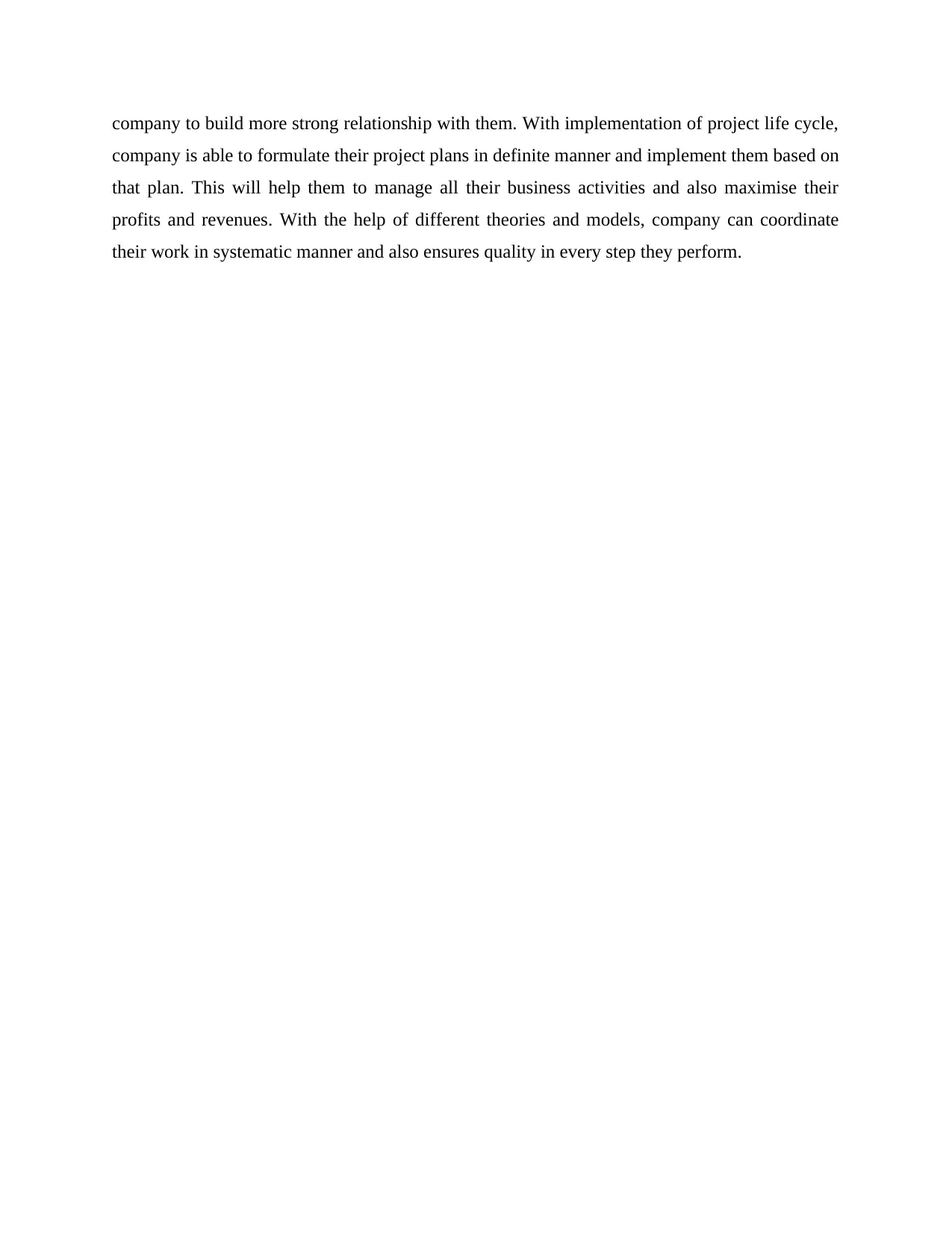
company to build more strong relationship with them. With implementation of project life cycle,
company is able to formulate their project plans in definite manner and implement them based on
that plan. This will help them to manage all their business activities and also maximise their
profits and revenues. With the help of different theories and models, company can coordinate
their work in systematic manner and also ensures quality in every step they perform.
company is able to formulate their project plans in definite manner and implement them based on
that plan. This will help them to manage all their business activities and also maximise their
profits and revenues. With the help of different theories and models, company can coordinate
their work in systematic manner and also ensures quality in every step they perform.
Paraphrase This Document
Need a fresh take? Get an instant paraphrase of this document with our AI Paraphraser
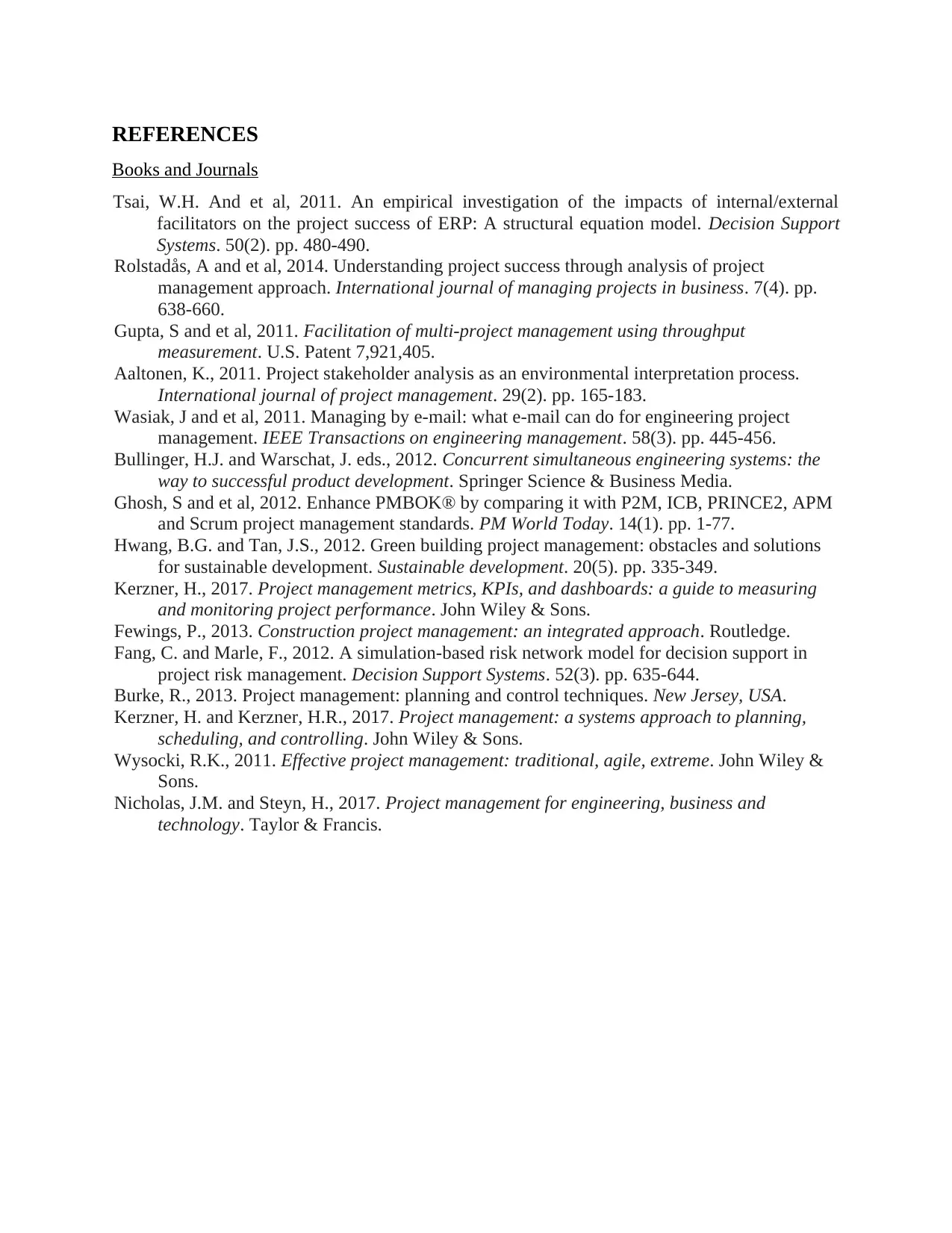
REFERENCES
Books and Journals
Tsai, W.H. And et al, 2011. An empirical investigation of the impacts of internal/external
facilitators on the project success of ERP: A structural equation model. Decision Support
Systems. 50(2). pp. 480-490.
Rolstadås, A and et al, 2014. Understanding project success through analysis of project
management approach. International journal of managing projects in business. 7(4). pp.
638-660.
Gupta, S and et al, 2011. Facilitation of multi-project management using throughput
measurement. U.S. Patent 7,921,405.
Aaltonen, K., 2011. Project stakeholder analysis as an environmental interpretation process.
International journal of project management. 29(2). pp. 165-183.
Wasiak, J and et al, 2011. Managing by e-mail: what e-mail can do for engineering project
management. IEEE Transactions on engineering management. 58(3). pp. 445-456.
Bullinger, H.J. and Warschat, J. eds., 2012. Concurrent simultaneous engineering systems: the
way to successful product development. Springer Science & Business Media.
Ghosh, S and et al, 2012. Enhance PMBOK® by comparing it with P2M, ICB, PRINCE2, APM
and Scrum project management standards. PM World Today. 14(1). pp. 1-77.
Hwang, B.G. and Tan, J.S., 2012. Green building project management: obstacles and solutions
for sustainable development. Sustainable development. 20(5). pp. 335-349.
Kerzner, H., 2017. Project management metrics, KPIs, and dashboards: a guide to measuring
and monitoring project performance. John Wiley & Sons.
Fewings, P., 2013. Construction project management: an integrated approach. Routledge.
Fang, C. and Marle, F., 2012. A simulation-based risk network model for decision support in
project risk management. Decision Support Systems. 52(3). pp. 635-644.
Burke, R., 2013. Project management: planning and control techniques. New Jersey, USA.
Kerzner, H. and Kerzner, H.R., 2017. Project management: a systems approach to planning,
scheduling, and controlling. John Wiley & Sons.
Wysocki, R.K., 2011. Effective project management: traditional, agile, extreme. John Wiley &
Sons.
Nicholas, J.M. and Steyn, H., 2017. Project management for engineering, business and
technology. Taylor & Francis.
Books and Journals
Tsai, W.H. And et al, 2011. An empirical investigation of the impacts of internal/external
facilitators on the project success of ERP: A structural equation model. Decision Support
Systems. 50(2). pp. 480-490.
Rolstadås, A and et al, 2014. Understanding project success through analysis of project
management approach. International journal of managing projects in business. 7(4). pp.
638-660.
Gupta, S and et al, 2011. Facilitation of multi-project management using throughput
measurement. U.S. Patent 7,921,405.
Aaltonen, K., 2011. Project stakeholder analysis as an environmental interpretation process.
International journal of project management. 29(2). pp. 165-183.
Wasiak, J and et al, 2011. Managing by e-mail: what e-mail can do for engineering project
management. IEEE Transactions on engineering management. 58(3). pp. 445-456.
Bullinger, H.J. and Warschat, J. eds., 2012. Concurrent simultaneous engineering systems: the
way to successful product development. Springer Science & Business Media.
Ghosh, S and et al, 2012. Enhance PMBOK® by comparing it with P2M, ICB, PRINCE2, APM
and Scrum project management standards. PM World Today. 14(1). pp. 1-77.
Hwang, B.G. and Tan, J.S., 2012. Green building project management: obstacles and solutions
for sustainable development. Sustainable development. 20(5). pp. 335-349.
Kerzner, H., 2017. Project management metrics, KPIs, and dashboards: a guide to measuring
and monitoring project performance. John Wiley & Sons.
Fewings, P., 2013. Construction project management: an integrated approach. Routledge.
Fang, C. and Marle, F., 2012. A simulation-based risk network model for decision support in
project risk management. Decision Support Systems. 52(3). pp. 635-644.
Burke, R., 2013. Project management: planning and control techniques. New Jersey, USA.
Kerzner, H. and Kerzner, H.R., 2017. Project management: a systems approach to planning,
scheduling, and controlling. John Wiley & Sons.
Wysocki, R.K., 2011. Effective project management: traditional, agile, extreme. John Wiley &
Sons.
Nicholas, J.M. and Steyn, H., 2017. Project management for engineering, business and
technology. Taylor & Francis.
1 out of 14
Related Documents
Your All-in-One AI-Powered Toolkit for Academic Success.
+13062052269
info@desklib.com
Available 24*7 on WhatsApp / Email
![[object Object]](/_next/static/media/star-bottom.7253800d.svg)
Unlock your academic potential
© 2024 | Zucol Services PVT LTD | All rights reserved.





